Podcast
Questions and Answers
What happens when light hits a surface?
What happens when light hits a surface?
- It disappears
- It gets absorbed
- It changes direction (correct)
- It stays the same
What is the reason we have day and night?
What is the reason we have day and night?
- The Earth spinning around the Sun
- The Earth rotating on its axis (correct)
- The Sun moving around the Earth
- The Moon orbiting the Earth
What is the opposite of day?
What is the opposite of day?
- Night (correct)
- Evening
- Morning
- Afternoon
Which planet do we live on?
Which planet do we live on?
What is the center of our Solar System?
What is the center of our Solar System?
What is the process called when light bounces back after hitting a surface?
What is the process called when light bounces back after hitting a surface?
What is the main reason we have day and night on Earth?
What is the main reason we have day and night on Earth?
What is the largest planet in our Solar System?
What is the largest planet in our Solar System?
What is the farthest planet from the Sun in our Solar System?
What is the farthest planet from the Sun in our Solar System?
What is the time period it takes the Earth to complete one rotation?
What is the time period it takes the Earth to complete one rotation?
Flashcards are hidden until you start studying
Study Notes
Understanding Light
- Light is a form of energy that allows us to see objects
- Light travels in straight lines and can bounce off mirrors and other shiny surfaces
- The bouncing back of light is called reflection
Reflection of Light
- When light hits a mirror or a shiny surface, it bounces back
- The angle of incidence (incoming light) is equal to the angle of reflection (bounced light)
- Mirrors can be used to reflect light and make objects appear larger or smaller
The Solar System
- Our solar system consists of eight planets: Mercury, Venus, Earth, Mars, Jupiter, Saturn, Uranus, and Neptune
- The sun is at the center of our solar system and the planets orbit around it
- The planets differ in size, temperature, and composition
Day and Night
- Day occurs when the part of the Earth facing the sun is lit up
- Night occurs when the part of the Earth facing away from the sun is in darkness
- The rotation of the Earth on its axis causes day and night to alternate every 24 hours
Understanding Light
- Light is a form of energy that allows us to see objects
- Light travels in straight lines and can bounce off mirrors and other shiny surfaces
- The bouncing back of light is called reflection
Reflection of Light
- When light hits a mirror or a shiny surface, it bounces back
- The angle of incidence (incoming light) is equal to the angle of reflection (bounced light)
- Mirrors can be used to reflect light and make objects appear larger or smaller
The Solar System
- Our solar system consists of eight planets: Mercury, Venus, Earth, Mars, Jupiter, Saturn, Uranus, and Neptune
- The sun is at the center of our solar system and the planets orbit around it
- The planets differ in size, temperature, and composition
Day and Night
- Day occurs when the part of the Earth facing the sun is lit up
- Night occurs when the part of the Earth facing away from the sun is in darkness
- The rotation of the Earth on its axis causes day and night to alternate every 24 hours
Studying That Suits You
Use AI to generate personalized quizzes and flashcards to suit your learning preferences.




